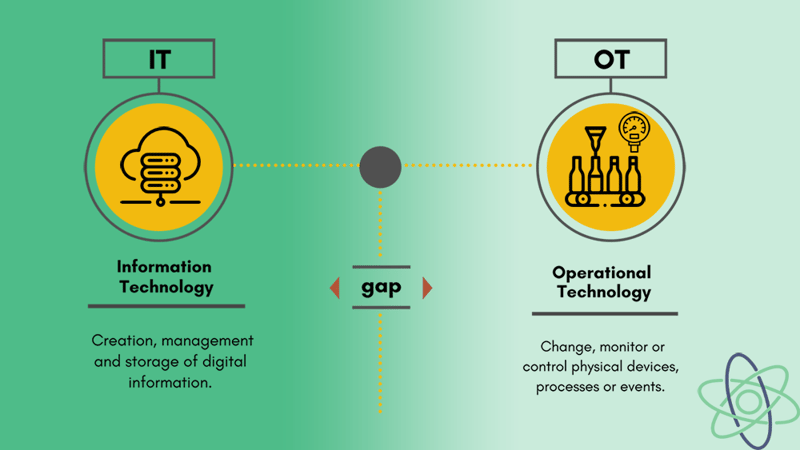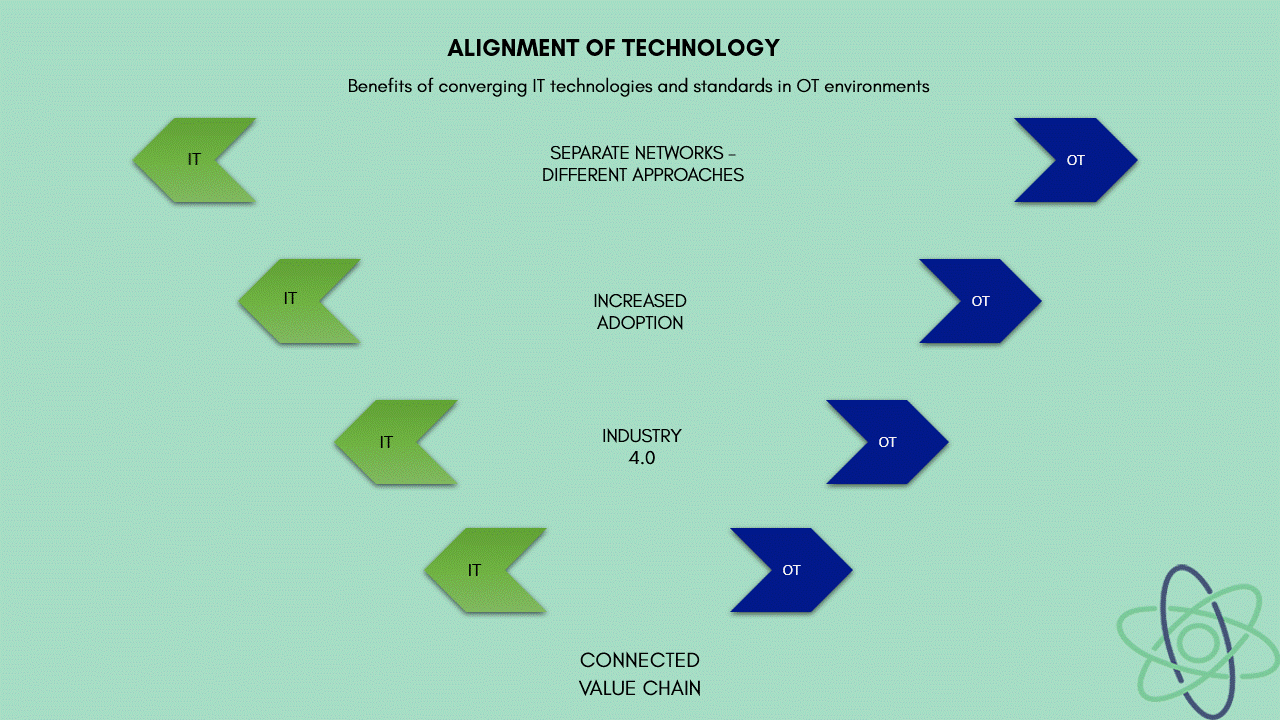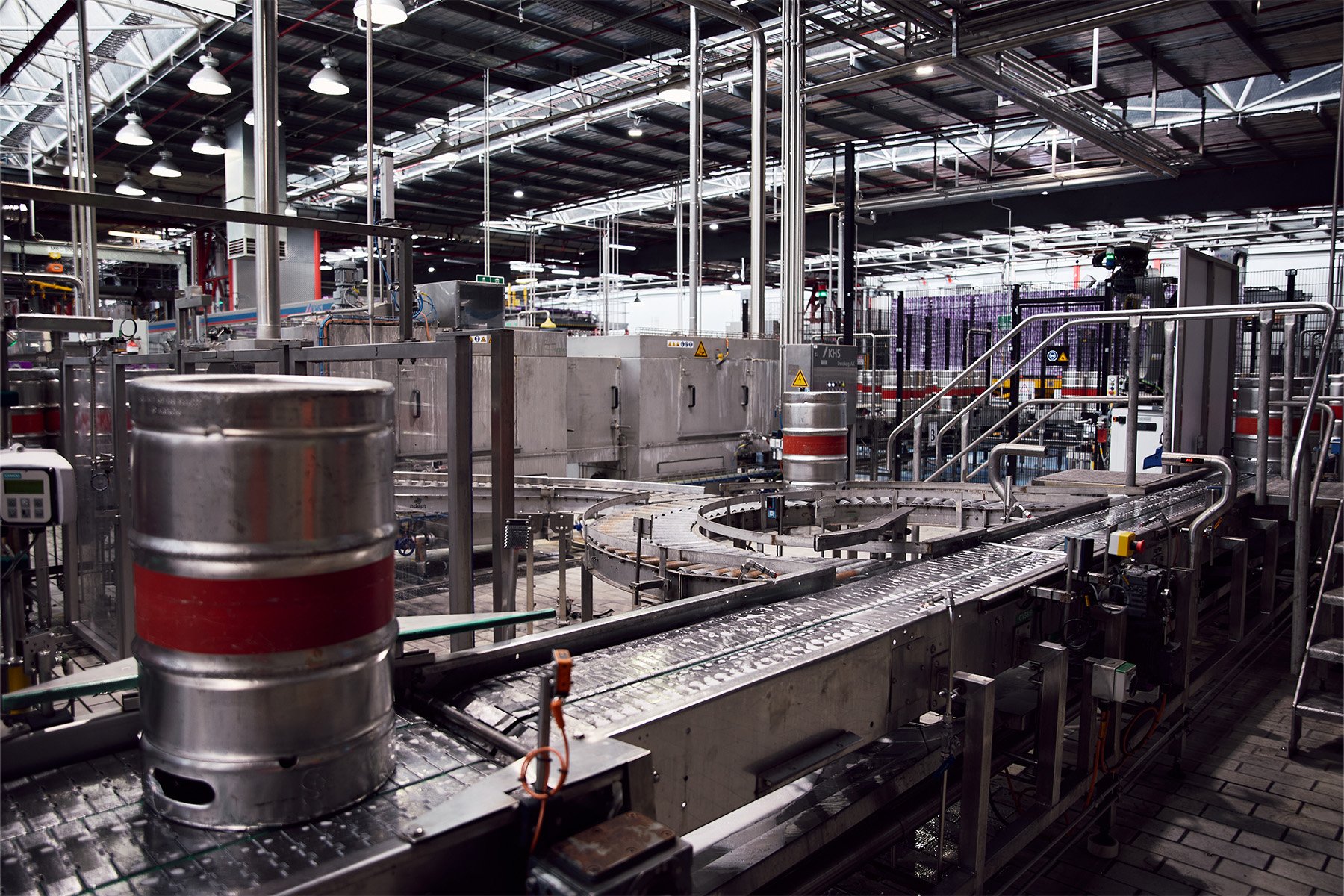Reducing costly unplanned downtime, improving performance and agility – the promised advantages of Industry 4.0 certainly sound enticing.
What industry experts have found is that while organizations see the benefits of digital transformation, they often don’t have the time or skills to drive the complex changes needed to get it off the ground.
Facing an extensive change management process, as well as replacing or integrating legacy systems, organizations can stall in the early stage: IT-OT convergence.
We spoke with Nukon's Gareth Williams and Matt Pyke to find out some of the key considerations when integrating IT and OT systems, and how your business can prepare for the convergence of these resources.
What is IT-OT convergence?
Gareth:

"Aligning information technology (IT) and operational technology (OT) enables processes to be combined and information to be shared across the two 'worlds’. This can be used to drive better management of systems and assets within your facility."
Previously the two systems have been independent – IT processes have largely revolved around data, information, communications-oriented systems and business networks, while OT is used to change, monitor or control physical devices, processes and events.
When we consider that IT has typically overseen hardware such as laptops and servers, as well as software such as ERPs; and that OT hardware and software is focused on what controls and manages processes on the floor (control systems, data acquisition system and industrial networks – including systems like PLCs, SCADA and MES), it's easier to see where there have been clear divisions between the two.
Why were information technology and operational technology separate in the past?
Gareth:
In short, the two departments existed in different worlds.
IT and OT have traditionally had very different components and technologies, as well as different operating philosophies and agendas.
The world of IT was designed to digitise business information systems and customer data, while OT was focused on the need to keep production moving. Operators in the OT space were focused on maintaining machine uptime and throughput, seeking ways to increase productivity on the shop floor.

Matt:
Because they had separate functions, IT and OT teams were able to operate independently. Now, digital transformation and the move towards connected systems has changed that and we’re seeing integration between the two worlds becoming critical for success.
As IT and OT areas have been separated in the past, your current teams might not have a clear understanding of what the other does, or why it’s necessary to consider both ‘worlds’ in a digital journey. There can also be some existing reservations (or even frustrations) about the way the two departments work, but alignment has never been more crucial for success.
Read more: Why business intelligence will help align IT and engineering departments
What does IT-OT convergence really mean?
Gareth:
Put simply, IT-OT convergence involves transferring information across both the IT and OT networks.
This connectivity can be used to enhance the value the systems deliver and progress your organization further towards your business goal – as long as you’re clear about what that is.
While many businesses want fully connected operations to get clear data from both sides, they can underestimate the planning needed to collect and correlate the right data, in the right format.
To get those valuable insights from your chosen platform, your business needs to be clear on HOW that data will be used to ensure it can be appropriately contextualized. Without the proper planning and strategy upfront, all that data can end up in a data store that may make it difficult to contextualize, or worse, that's not going to make the data available in the right format to be used to make both valuable and beneficial decisions.
By collecting the most valuable operational data from OT systems, your IT systems can process and analyse this data to generate the helpful insights needs that can be used to support real-time decision-making, which presents a huge opportunity for improving efficiency.

What other IT-OT convergence benefits are there?
- Sharing data previously held in disparate systems, resulting in information being more accessible to all parts of your business
- Improved visibility across the business, being able to analyse data as a whole instead of in isolation
- Reduced risk in manufacturing
- Better disaster recovery processes - such as improved backup processes, or the use of cloud infrastructure with additional redundancy and automated failover in the event of a disaster.
True IT/OT convergence removes the divide between operational processes and information systems and combines them in a unified network architecture.
Key takeaway:
There's clear value in integrating the two ‘worlds’, but in any organisation, connecting these systems also disrupts traditional processes and business models. It needs to be carefully planned to bring the right value now and into the future.
There are key skills needed to determine how to pull the disparate data together and how to overcome the existing separation. We’ll get into that more in a moment.
How does IT-OT convergence add value?
Matt:
 "Organisations mapping out their digital transformation journey may already understand the value of having systems that 'talk’ to one another. Planning for integration may even be in the discussion as more organisations aim to take advantage of real-time data."
"Organisations mapping out their digital transformation journey may already understand the value of having systems that 'talk’ to one another. Planning for integration may even be in the discussion as more organisations aim to take advantage of real-time data."
Bringing together disparate systems and breaking down the silos between departments provides opportunities to scale digital transformation projects (and business growth) while bringing greater value to both the organisation and customers.
For example, optimising the stock allocation and dispatch schedule for fresh goods to be shipped from a warehouse to retailers helps identify potential bottlenecks through future order visibility. Connecting sales order and forecast data with dispatch variables such as lead times, truck capacity and load due-in date enable the warehouse to better meet demands and deliver goods. Stores see less direct sales lost and consumers can access fresh goods in-store.
Integrating your IT and OT systems can provide an intuitive, real-time representation of the current operational situation using modern technologies and standards. This includes the ability to represent, trend, predict and resource accurately and automatically in real-time.
With this information, it becomes easier for a business to optimise production, be more flexible and efficient.
Read more: Real-time data delivers a smarter airport and world-class customer experience
What are the critical enablers for the convergence of OT and IT?
Gareth:
As we’ve covered, integrating business systems for greater visibility in an industrial environment provides competitive opportunities, but there’s also plenty of risks and LOTS of process change ahead.
Before getting started, you need the following:
1. People who can work in cross-functional teams
For successful IT-OT integration, you need the knowledge and support of both your operations and IT teams.
While operations teams know there are huge amounts of data available on the shop floor, input from IT teams is needed during setup, and to make the data more accessible across the business.
A cross-functional team can explore potential challenges to IT-OT convergence within your business and decide whether there’s a need to bring in a digital consultation company to accelerate the shift.
Many organisations are seeing a greater push towards real-time data and data flowing through from multiple areas of the business. With a blended skillset and a hybrid team that is jointly responsible for the management and delivery of IT/OT, this can mitigate risk and allow you to start gaining insights faster.
2. An IT-OT convergence strategy (and wider digital transformation strategy)
If your company is not clear on the value you hope to get from integrating IT and OT departments, it’s crucial you take the time to determine this. Identify the priorities, and plan how to align systems to capability and your overall business strategy.
Read more: A quick start guide to executing digitalisation
3. An understanding of your technology
Air gapped networks – the OT network is independent of IT networks, so there is currently no exchange of data or convergence. The computers or networks are not connected to the internet.
Interconnected networks - used when you don’t want to join these networks. Instead, they are segregated to limit the data flowing back and forth – so only the data you want is being captured.
Either way, your IT and OT teams should be protecting each other's networks from different threats and attack vectors. Keep in mind that OT technology isn’t as fast-moving as IT, so you need to identify who will be responsible for monitoring those networks.
 Critical enablers for integrating IT and OT in your organisation
Critical enablers for integrating IT and OT in your organisation
What skills do you need to start integrating your IT and OT departments?
Matt:
As we talked about earlier, many organisations feel they lack the skills to enable smooth IT-OT integration.
In this process, be brutally honest about your strengths and weaknesses as an organisation – and decide if an external partner can bring the perspective you need.
Finding a partner who can work with you and your business to help identify what you need, and what support is needed makes the integration process easier.
A good digital transformation consultant will seek clarity on the goals of your organisation, before spending time understanding both the needs and vision of your stakeholders.
Connecting your IT and OT worlds
Bridging the gap between information technology and operational technology is inevitable for your business to successfully progress with Industry 4.0 initiatives.
IT/OT convergence enables the wealth of data from your OT assets to be communicated directly with your IT systems, providing an opportunity to unlock value.
After reading this article, hopefully, you have a stronger understanding of the value of integrating IT and OT. In an upcoming article, we’ll be looking more closely at the process of integration – and those crucial first steps.





